Rascals case in brief
In the beginning, in 1989, more than 90 children at the Little Rascals Day Care Center in Edenton, North Carolina, accused a total of 20 adults with 429 instances of sexual abuse over a three-year period. It may have all begun with one parent’s complaint about punishment given her child.
Among the alleged perpetrators: the sheriff and mayor. But prosecutors would charge only Robin Byrum, Darlene Harris, Elizabeth “Betsy” Kelly, Robert “Bob” Kelly, Willard Scott Privott, Shelley Stone and Dawn Wilson – the Edenton 7.
Along with sodomy and beatings, allegations included a baby killed with a handgun, a child being hung upside down from a tree and being set on fire and countless other fantastic incidents involving spaceships, hot air balloons, pirate ships and trained sharks.
By the time prosecutors dropped the last charges in 1997, Little Rascals had become North Carolina’s longest and most costly criminal trial. Prosecutors kept defendants jailed in hopes at least one would turn against their supposed co-conspirators. Remarkably, none did. Another shameful record: Five defendants had to wait longer to face their accusers in court than anyone else in North Carolina history.
Between 1991 and 1997, Ofra Bikel produced three extraordinary episodes on the Little Rascals case for the PBS series “Frontline.” Although “Innocence Lost” did not deter prosecutors, it exposed their tactics and fostered nationwide skepticism and dismay.
With each passing year, the absurdity of the Little Rascals charges has become more obvious. But no admission of error has ever come from prosecutors, police, interviewers or parents. This site is devoted to the issues raised by this case.
On Facebook
Click for earlier Facebook posts archived on this site
Click to go to
Today’s random selection from the Little Rascals Day Care archives….
Click for earlier Facebook posts archived on this site
Click to go to
Today’s random selection from the Little Rascals Day Care archives….
DA acknowledges junk science in arson conviction

brooklynda.org
Ken Thompson
Dec. 17, 2015
“Three men convicted of murder by arson for a 1980 fire in Brooklyn (were) exonerated on Wednesday….
“What carried the three men into prison was not reliable evidence of an intentionally set blaze, but rather an arson investigation that was more like shamanism than science, rooted in hunches and folklore and disconnected from the dynamics of actual fires. Like the comparisons of bite marks, hair and handwriting, it was a forensic practice that had the authority of white-coat laboratory science but virtually none of its rigor….”
– From “Between Guilt and Innocence, an Evolution in Fire Science”
by Jim Dwyer in the New York Times (Dec. 16)
Hats off to District Attorney Ken Thompson, who moved to vacate the three convictions, citing “circumstantial evidence, outdated science and the testimony of a single, wholly unreliable witness….”
Columnist Dwyer is reminded of a statue at the University of Pennsylvania Law School depicting a mythological Chinese beast believed to have the ability to tell the guilty from the innocent by butting them. Inscribed on its base: “Slow and painful has been man’s progress from magic to law.”
“Slow and painful” indeed. Ask Junior Chandler, who has been imprisoned since April 17, 1987, for committing the magical crime of “satanic ritual abuse.”
High school students introduced to ‘Innocence Lost’

pastdaily.com
Edward R. Murrow
June 10, 2016
It’s heartening to see that, 25 years later, “Innocence Lost” is still shining light on the wrongful prosecution of the Edenton Seven – and for a younger audience! This is a note from Judy Griffin, a teacher at Hamilton High School in Michigan, who recently rediscovered Ofra Bikel’s eight-hour masterpiece:
“I want you to know how helpful it is (to have “Innocence Lost” available online). I teach in a resource room English class. The kids have no cognitive issues, but reading is a tremendous struggle. When they can receive the information through really good videos like this one, we can cover some great information.
“We start by reading Edward R. Murrow’s introduction to ‘This I Believe.’ Then the students create digital versions of their own. After that, they view ‘Good Night, and Good Luck.’ They have just learned about McCarthyism at this point in U.S. History, so it is fresh in their minds.
“We move then into The Crucible. The students are then asked to compare this to ‘Good Night, and Good Luck.’ They read ‘Why I wrote The Crucible’ by Arthur Miller.
“At the conclusion, we talk about how these hysterias are repeated and actually happened even prior to Salem. I introduce the Day Care scandal, and was thrilled to find the original ‘Frontline’ episodes. I had seen it when it aired!
“They are now researching various aspects of the hysteria. Some are looking at ‘satanic ritual abuse,’ some are looking at how hysteria spreads, some are researching what happened to the various defendants, and some are looking at the causes. We emphasize that this is not unique to any of these situations, and the point of this all is to show how vulnerable societies are to hysteria….”
![]()
Prosecutors must recognize vulnerability to cognitive flaws

mic.com
Michael Shammas
Nov. 17, 2016
“It’s no secret that we humans grant far too much confidence to our opinions. But when powerful people do this, the dangers compound. Zealotry replaces fair-mindedness. The worst excesses happen when prosecutors forget they’re flawed humans, like anyone else, and that as a result they’re subject to cognitive flaws like tunnel vision, racial bias, and the desire to reduce cognitive dissonance through ‘cognitive consistency’ even at the expense of complicated, nuanced, self-contradictory, paradoxical truth….
“Cognitive bias and overconfidence touch us all. Only a conscious awareness that we might be wrong can counter unthinking heuristics, biases, and schemas that lead to imperfect conclusions….
“Wisdom counsels not the confident use of power, but the wise use of power. The first step of wisdom is recognizing how little we know….”
– From “ ‘Making a Murderer’ Attorney Highlights Our Troubling Rate of Wrongful Conviction — and Suggests a Solution” by Michael Shammas in the Huffington Post (July 12)
And the latest on the still-imprisoned Brendan Dassey.
![]()
Newspaper saw Kelly conviction as ‘breakthrough’
Oct. 2, 2013
“…It’s understandable that this week’s conviction of former day-care center owner Robert Fulton Kelly Jr. in Farmville, N.C., is being hailed as a breakthrough…. The conviction increases public awareness of child abuse, serves notice that children should be taken seriously when they show signs of abuse, and calls attention to improved methods of handling such prosecutions.
“Since another long and costly child abuse case at a California day-care center nearly a decade ago that ended less conclusively than the one in North Carolina, prosecutors have learned much. They have learned how to question children without prompting them, have developed better investigative methods, and have improved the coordination between different agencies.
“But that’s not enough. Parents need to be more alert to detecting possible child abuse and more careful about picking safe, responsible day care centers. Despite this week’s conviction… it would be wrong and unfair to conclude that many day-care workers are degenerates.”
– From “How to Guard Against Child Abuse” in the Deseret News of Salt Lake City (April 25 1992)
During the era of day-care ritual-abuse allegations, most newspaper editorials managed to maintain at least a modicum of skepticism. Not this one – unless you count the Deseret News’ acknowledging a modicum of doubt “that many day-care workers are degenerates.”











0 CommentsComment on Facebook